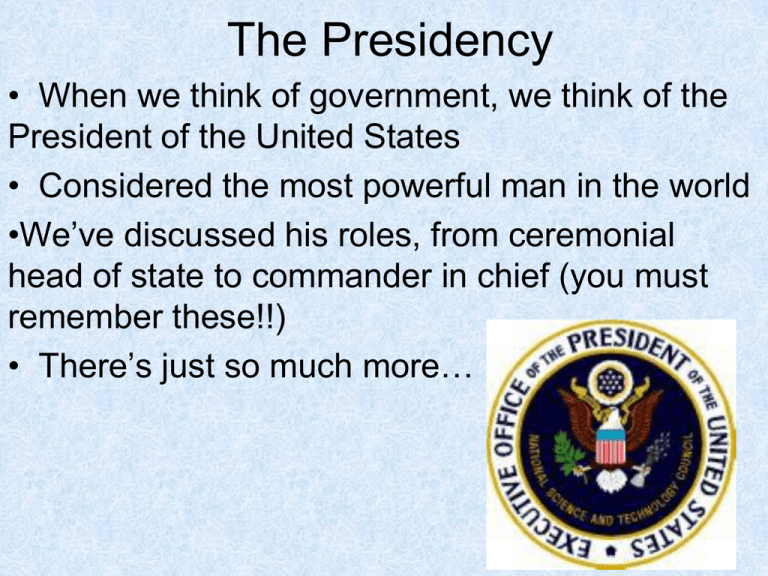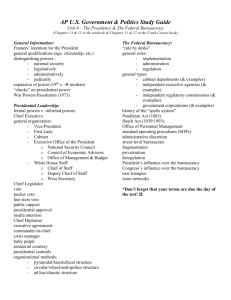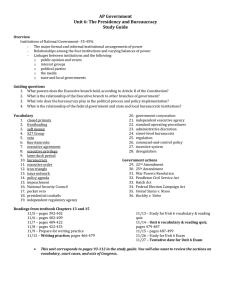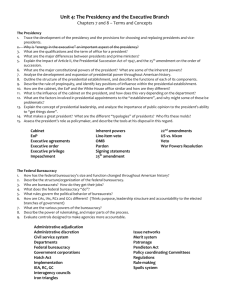The Presidency
advertisement

The Presidency • When we think of government, we think of the President of the United States • Considered the most powerful man in the world •We’ve discussed his roles, from ceremonial head of state to commander in chief (you must remember these!!) • There’s just so much more… The Founding Fathers • • • • • The feared both anarchy and monarchy Fear of corruption by Senate – shared powers Fear of presidential bribery to ensure reelection Concern was balance of power How long do they serve – 2 term precedent but 22nd Amendment ensures that • Establishment of legitimacy of office • and orderly transfer of power • One solution – the Electoral College The Electoral College • A blessing and a curse… • Created to ensure fair and balanced way to select a president • Each state chooses delegates and met in their own capital to pick a president (now they meet in a national convention) • Winner takes all approach and if no one wins a majority, then the House picks the president!! • Needs to be reformed as the electorate is more informed and educated – maybe a percentage of electoral votes to each candidate?? The beginnings… • Power of early presidents gave legitimacy to office(Washington, Adams, Jefferson, Madison) • Not a lot of activism so people didn’t fear the president (like a monarch) • Good relations with Congress, basically • Jackson believed in very strong presidency!!! Used his veto power, was very popular!! • Congress regains power from president until FDR and since then it’s been pretty even Powers of the President • Powers are found in Article II of the Constitution • Presidents power can also be found in the ambiguous clauses of the Constitution including his C and C powers, duty to execute the laws, etc • The Presidents greatest source of power comes from politics and public opinion (authority and expectations) Other powers include… • Executive powers – execute laws, direct administration, appoint officials, foreign policy • Legislative powers – recommend legislation, veto legislation and call special sessions • Judicial powers – grant reprieves, grant pardons, commute sentences, grant amnesty The White House Office • This is the presidential staff – which the president really didn’t have until 1857 • The office is made up of the president’s closest assistants • Three types of structures of the Office… 1. Pyramid structure – hierarchy, Chief of Staff 2. Circular structure – all report to president 3. Ad hoc structure – informal, committees Typically a mix of all of these structures… More on the office… • President’s staff typically worked on the president’s campaign – supports presidential agenda and priorities!!!! • Lots of jockeying… everyone wants to be as close as possible to the president • Proximity plays a huge role in power outside of the president – be near the president and you think you have power, too… The Executive Office of the President • Known as the EOP • Shaped like an umbrella and is composed of agencies that report directly to the president such as… • The OMB – Office of Management and Budget • Independent agencies (regulatory commissions or corporations that carry out business like activities – created late 1800s) The Cabinet • Part of the EOP • Composed of 14 executive departments • Closest advisors to the president, but can act outside of his authority, advocate for their dept. • Each one headed by a “Secretary” except Dept. of Justice which is headed by Attorney General • Oldest and most prestigious is the State Dept and the biggest is the DOD (Pentagon) • While the Cabinet is not specifically mentioned in the Constitution, it wields a lot of power and influence!!!! (school example – principals staff are his closest advisors while the department chairs are the cabinet, out for themselves as well as the school) Characteristics of presidents • Recent personalities and characteristics: • • • • • • • • • • Eisenhower – orderly, military style Kennedy – bold, articulate, improviser Johnson – master legislative strategist, micromanager Nixon – expert foreign policy, hated personal confrontation Ford – discussion oriented, genial Carter – Washington outsider, micromanager Reagan – set priorities let staff work, leader of public opinion Bush, Sr. – Washington insider, hands-on manager style Clinton – good communicator, followed liberal/center agenda Bush, Jr. – tightly controlled White House, foreign affairs have dominated since 9/11 Power to persuade • President has huge ability to use office to persuade public and fellow politicians • Relies on prepared speeches – the bully pulpit • Can use popularity to gain congressional support for bills and agenda • Riding presidents coattails has been declining for years, minimal affect now • Popularity affected by many factors, look at Bush’s rating after 9/11 to now… • Usually highest during honeymoon period Other powers to remember • Veto power – includes pocket veto and overriding of a veto by Congress • Executive privilege – need for advice but not absolute (Nixon v US) • Impoundment of funds – president can choose not to spend money appropriated by Congress, but there are rules to this Presidential transition • Only 15 of 43 presidents have completed 2 terms – 8 have died in office (4 assassinated?) • Vice president’s job “rather empty” – President of Senate and only 5 have been elected pres. • Succession determined by 25th Amendment now but not before… • President ill?? VP in charge but who decides? • A new president after a death must choose a new VP and he or she must be confirmed by a majority of BOTH houses!!!!! Impeachment • More judges than presidents get impeached • Only Andrew Johnson, Nixon and Clinton could have been impeached • Nixon resigned but surely would have been • Johnson and Clinton indicted by House but not convicted in Senate How powerful is the President? • 1. 2. 3. • 1. 2. 3. Less now than before – many constraints on the job Complex issues Constant watch by the media More interest groups with more power! Responses to constraints include: Get things done during honeymoon Just a few priorities on agenda Give power to White House staff and supervise closely THE END!! But wait… The Federal Bureaucracy • Definition – a large complex organization of appointed officials • US system unique in that power is shared by president and congress and that federal agencies work with state and local agencies • Constitution had little to say about bureaucracy or how to make it work… go figure! • REMEMBER – we are talking about people who work for the government, on almost any level, as a “civilian” employee Brief history • The bureaucracy has played many roles over the years • Place to give jobs to your friends • Service oriented to the federal government • The Depression led to a more active role in government • Income taxes supported a huge bureaucracy and it’s growth • 9/11 has also increased size and scope of bureaucracy It’s… ALIVE!!! •There is a bureaucracy everywhere… • government, of course • schools • churches • your work place • your family • even among your friends because we need lots of help and guidence to get jobs done… They must… 1. Answer to competing sources of political authority 2. Function in a constitutional system that fragments power (decentralization) 3. Achieve vague and often competing goals (save the environment - produce fuel??) 4. Deal with few incentives that value efficiency The Bureaucracy continued… • The power of a bureaucracy must be measured by its authority, not by the number of employees or size of its budget • War and depression have been the main sources of bureaucratic growth over time • How bureaucrats use their authority can be explained by their recruitment and job security, their political views and by the nature of the tasks their agencies perform… More… • 1. 2. 3. 4. 5. When we think of bureaucracy we think of problems… Red tape - complex and conflicting rules Conflict - agencies work against each other Duplication - agencies do the same thing Imperialism - agencies grow regardless of budget, benefits or costs Waste - a famous by-product of bureaucracy Civil service… now anyway • Jobs in government used to be a reward for helping out a winning candidate - called patronage !!!!! • Now jobs are merit based - through the civil service system • This is due, in part, to the 1883 Pendleton Civil Service Act which established a civil service board and testing procedure for advancement • (remember political machines and giving jobs to favored assistants at the government’s expense??? No, rats…) Does it work?? • Look at the cartoon on page 425 - it shows that there is an entire language of the bureaucrat • One of the “rules” - never use ordinary words where unusual ones can be found! • On page 426 are the “laws” of bureaucrat procedure such as “there is never time to do it right the first time, but always time to do it over” • People make fun of the bureaucracy but should they?? Does it work? • Yes, actually, surprisingly well • Look at the mail service or the fact that we made it to the moon • But it could be better and more efficient perhaps Reforms • • 1. 2. • • Lots of attempts - 11 just in the 1990s Most revolve around centralizing authority Employee initiatives Fewer detailed rules and more customer satisfaction But difficult to accomplish Most rules and red tape are struggles between the president and Congress or are a by-product of divided government and micromanagement A final note • You must read this chapter - there is information on recruitment, growth, the changing role, the buddy system, the Iron Triangle, firing a bureaucrat, constraints on the job, a career in government, the benefits and drawbacks, and vocab…






